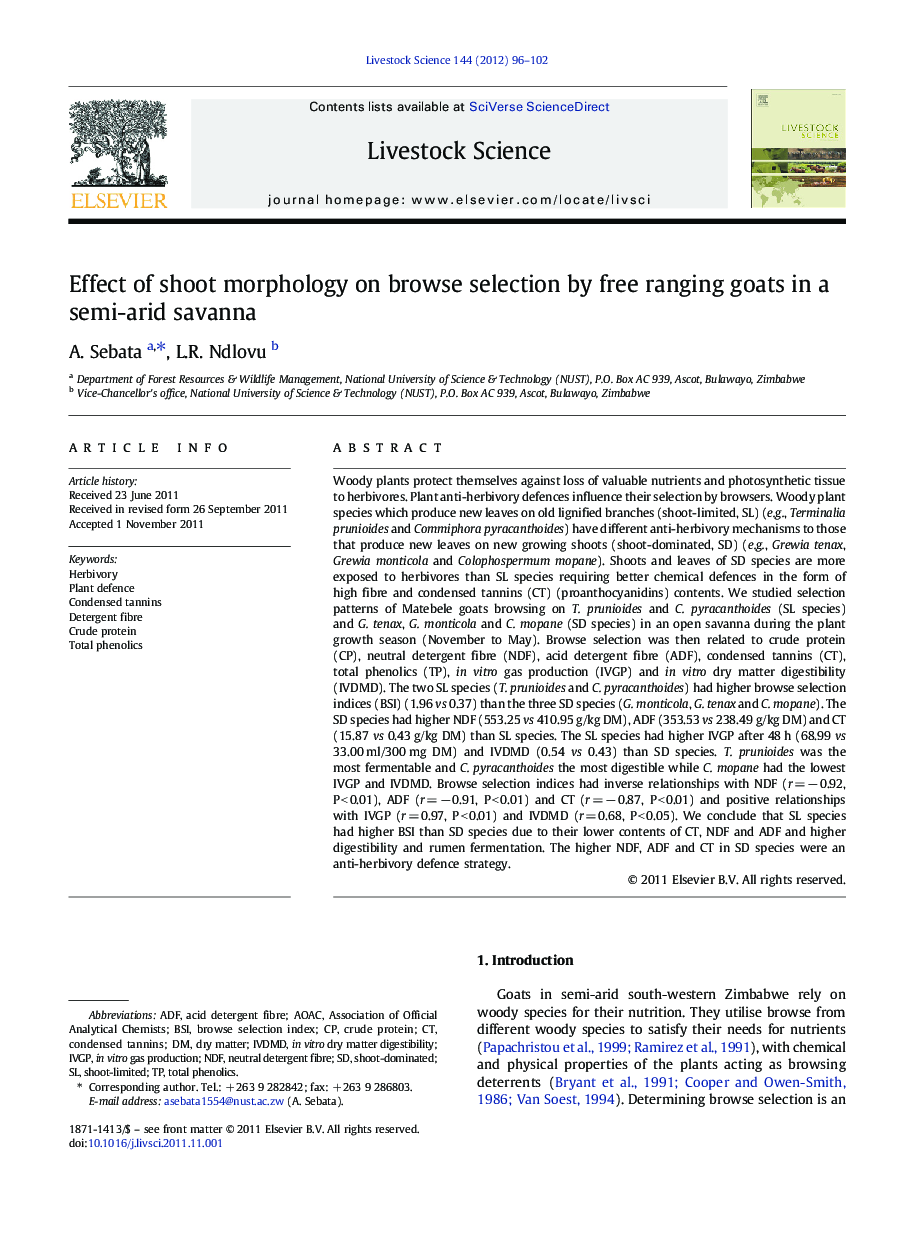| کد مقاله | کد نشریه | سال انتشار | مقاله انگلیسی | نسخه تمام متن |
|---|---|---|---|---|
| 5790930 | 1553988 | 2012 | 7 صفحه PDF | دانلود رایگان |
عنوان انگلیسی مقاله ISI
Effect of shoot morphology on browse selection by free ranging goats in a semi-arid savanna
دانلود مقاله + سفارش ترجمه
دانلود مقاله ISI انگلیسی
رایگان برای ایرانیان
کلمات کلیدی
ADFAOACBSINDFIVDMDacid detergent fibre - الیاف پاک کننده اسیدassociation of official analytical chemists - انجمن متخصصان تحلیلی رسمیCondensed tannins - تانن های متراکم یا تانن های فشردهIn vitro gas production - تولید گاز درون آزمایشگاهیPlant defence - دفاع گیاهneutral detergent fibre - فیبر مواد شوینده خنثیdry matter - ماده خشکIn vitro dry matter digestibility - هضم ماده خشک درون in vitrocrude protein - پروتئین خامTotal phenolics - کل فنولیکHerbivory - گیاهخواری
موضوعات مرتبط
علوم زیستی و بیوفناوری
علوم کشاورزی و بیولوژیک
علوم دامی و جانورشناسی
پیش نمایش صفحه اول مقاله

چکیده انگلیسی
Woody plants protect themselves against loss of valuable nutrients and photosynthetic tissue to herbivores. Plant anti-herbivory defences influence their selection by browsers. Woody plant species which produce new leaves on old lignified branches (shoot-limited, SL) (e.g., Terminalia prunioides and Commiphora pyracanthoides) have different anti-herbivory mechanisms to those that produce new leaves on new growing shoots (shoot-dominated, SD) (e.g., Grewia tenax, Grewia monticola and Colophospermum mopane). Shoots and leaves of SD species are more exposed to herbivores than SL species requiring better chemical defences in the form of high fibre and condensed tannins (CT) (proanthocyanidins) contents. We studied selection patterns of Matebele goats browsing on T. prunioides and C. pyracanthoides (SL species) and G. tenax, G. monticola and C. mopane (SD species) in an open savanna during the plant growth season (November to May). Browse selection was then related to crude protein (CP), neutral detergent fibre (NDF), acid detergent fibre (ADF), condensed tannins (CT), total phenolics (TP), in vitro gas production (IVGP) and in vitro dry matter digestibility (IVDMD). The two SL species (T. prunioides and C. pyracanthoides) had higher browse selection indices (BSI) (1.96 vs 0.37) than the three SD species (G. monticola, G. tenax and C. mopane). The SD species had higher NDF (553.25 vs 410.95 g/kg DM), ADF (353.53 vs 238.49 g/kg DM) and CT (15.87 vs 0.43 g/kg DM) than SL species. The SL species had higher IVGP after 48 h (68.99 vs 33.00 ml/300 mg DM) and IVDMD (0.54 vs 0.43) than SD species. T. prunioides was the most fermentable and C. pyracanthoides the most digestible while C. mopane had the lowest IVGP and IVDMD. Browse selection indices had inverse relationships with NDF (r = â 0.92, P < 0.01), ADF (r = â 0.91, P < 0.01) and CT (r = â 0.87, P < 0.01) and positive relationships with IVGP (r = 0.97, P < 0.01) and IVDMD (r = 0.68, P < 0.05). We conclude that SL species had higher BSI than SD species due to their lower contents of CT, NDF and ADF and higher digestibility and rumen fermentation. The higher NDF, ADF and CT in SD species were an anti-herbivory defence strategy.
ناشر
Database: Elsevier - ScienceDirect (ساینس دایرکت)
Journal: Livestock Science - Volume 144, Issues 1â2, March 2012, Pages 96-102
Journal: Livestock Science - Volume 144, Issues 1â2, March 2012, Pages 96-102
نویسندگان
A. Sebata, L.R. Ndlovu,